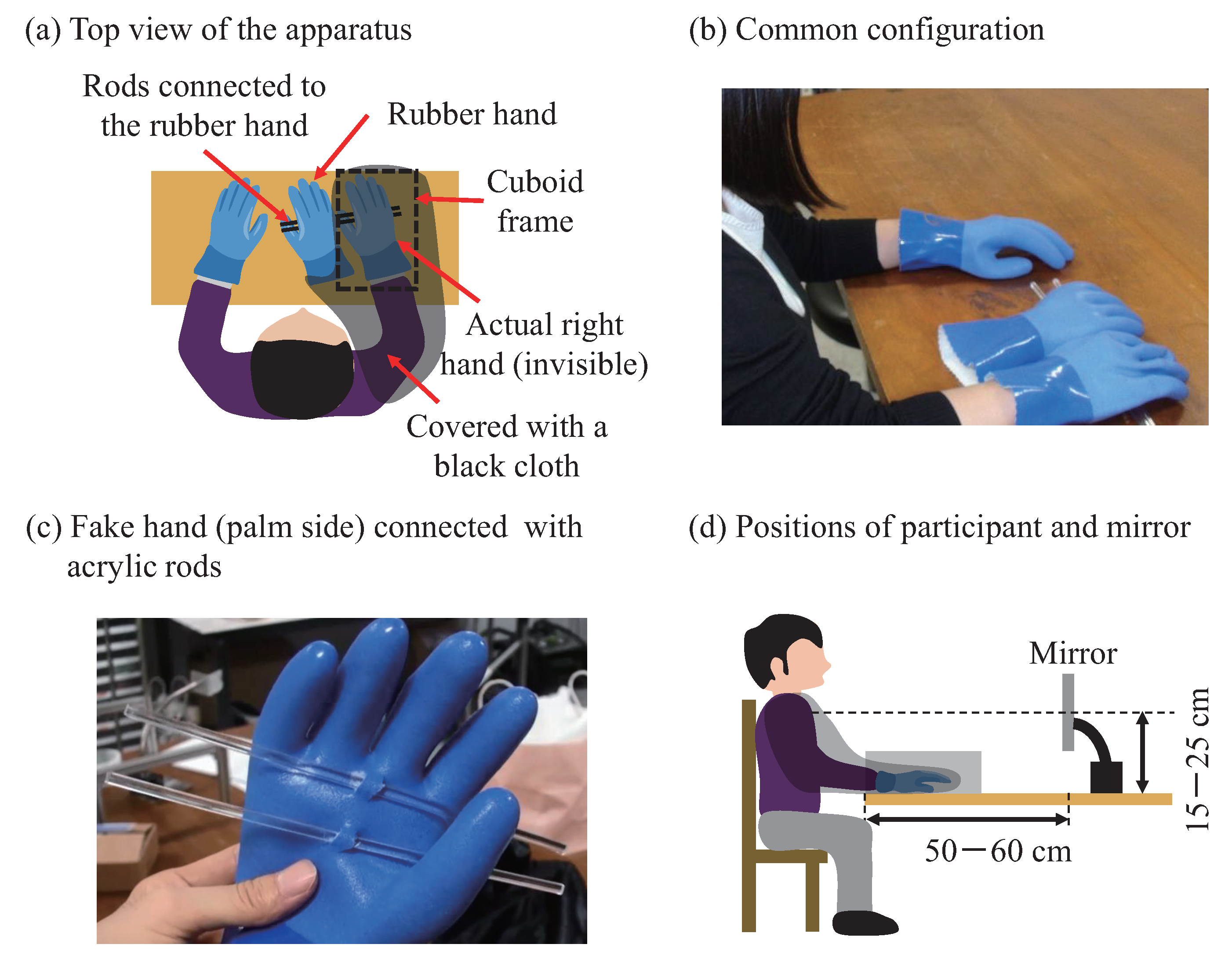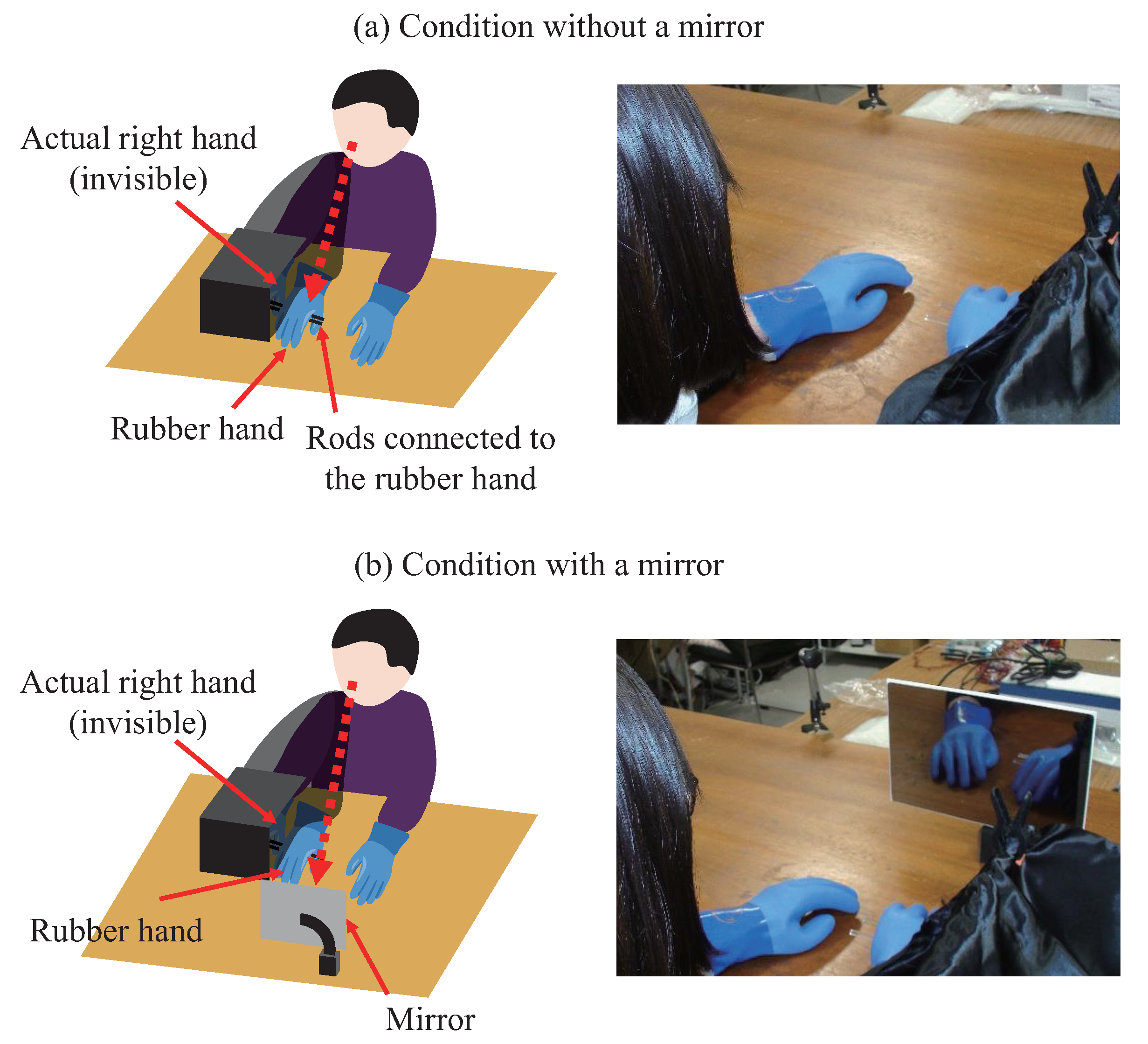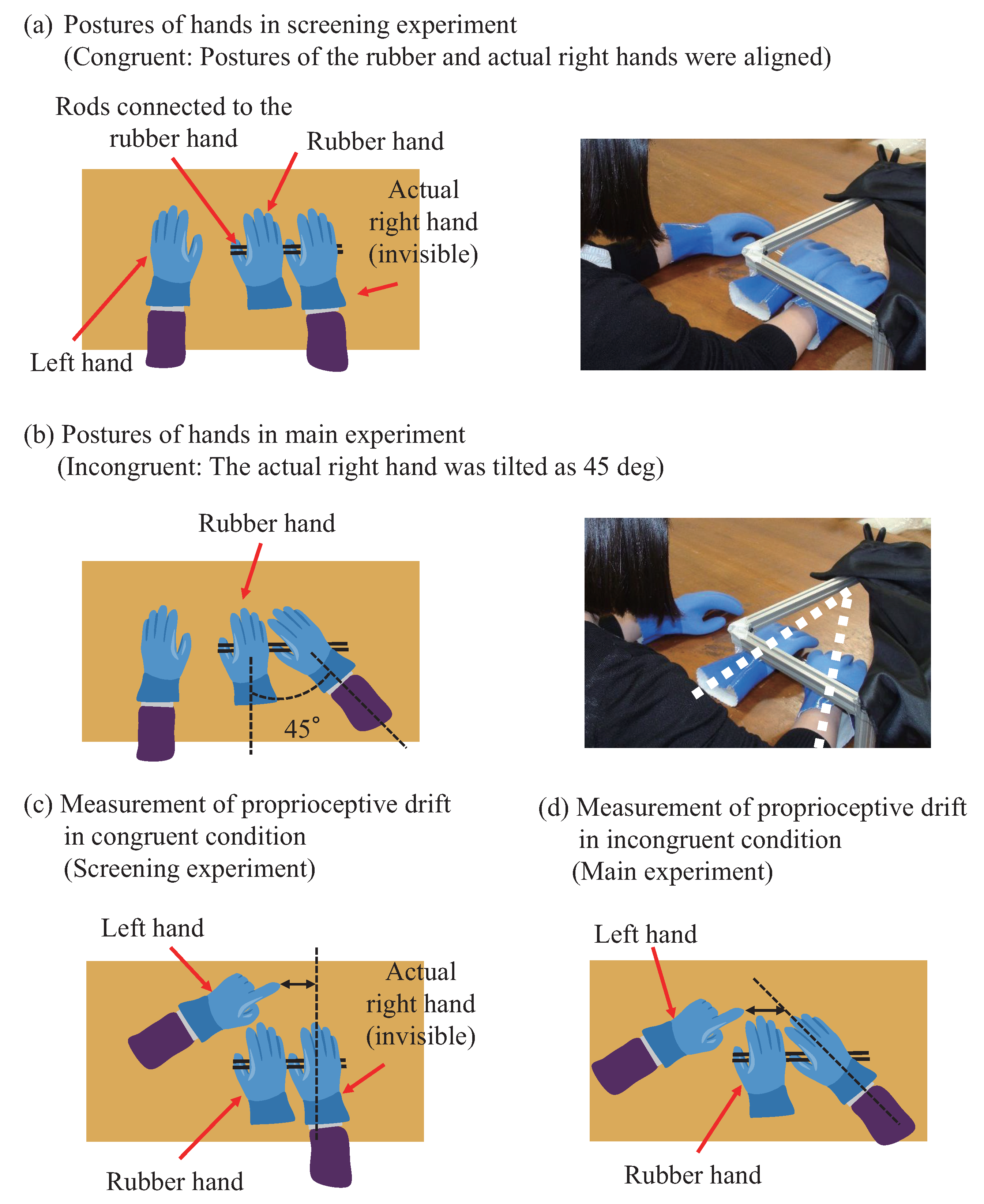Self-Body Recognition through a Mirror: Easing Spatial-Consistency Requirements for Rubber Hand Illusion
Abstract
:1. Introduction
2. Materials and Methods
2.1. Participants
2.2. Apparatus for Inducing RHI under Self-Generated Movement
2.3. Common Tasks for Both Screening and Main Experiment
2.4. Screening Experiment: Follow-Up Test of Mirror RHI Involving Self-Generated Movement
2.5. Main Experiment: RHI under an Incongruent Hand Posture with a Mirror Image of the Fake Hand
2.6. Modified RHI Questionnaire
2.7. Proprioceptive Drift toward the Rubber Hand
2.8. Analysis
3. Results
3.1. Results of Screening Experiment
3.1.1. Questionnaire Scores
3.1.2. Proprioceptive Drift
3.2. Results of Main Experiment
3.2.1. Questionnaire Scores
3.2.2. Proprioceptive Drift
4. Discussion
5. Conclusions
Author Contributions
Funding
Acknowledgments
Conflicts of Interest
References
- Botvinick, M.; Cohen, J. Rubber hands ‘feel’ touch that eyes see. Nature 1998, 391, 756. [Google Scholar] [CrossRef] [PubMed]
- Ehrsson, H.; Holmes, N.; Passingham, R. Touching a rubber hand: Feeling of body ownership is associated with activity in multisensory brain areas. J. Neurosci. 2005, 25, 10564–10573. [Google Scholar] [CrossRef]
- Shimada, S.; Fukuda, K.; Hiraki, K. Rubber hand illusion under delayed visual feedback. PLoS ONE 2009, 4, e6185. [Google Scholar] [CrossRef] [PubMed] [Green Version]
- Pavani, F.; Spence, C.; Driver, J. Visual capture of touch: Out-of-the-body experiences with rubber gloves. Psychol. Sci. 2000, 11, 353–359. [Google Scholar] [CrossRef] [PubMed]
- Tsakiris, M.; Haggard, P. The rubber hand illusion revisited: Visuotactile integration and self-attribution. J. Exp. Psychol. Hum. Percept. Perform. 2005, 31, 80–91. [Google Scholar] [CrossRef] [Green Version]
- Costantini, M.; Haggard, P. The rubber hand illusion: Sensitivity and reference frame for body ownership. Conscious. Cogn. 2007, 16, 229–240. [Google Scholar] [CrossRef]
- Austen, E.L.; Soto-Faraco, S.; Enns, J.T.; Kingstone, A. Mislocalizations of touch to a fake hand. Cogn. Affect. Behav. Neurosci. 2004, 4, 170–181. [Google Scholar] [CrossRef]
- Lloyd, D.M. Spatial limits on referred touch to an alien limb may reflect boundariesof visuo-tactile peripersonal space surrounding the hand. Brain Cogn. 2007, 64, 104–109. [Google Scholar] [CrossRef]
- Ide, M. The effect of anatomical plausibility of hand angle on the rubber-hand illusion. Perception 2013, 42, 103–111. [Google Scholar] [CrossRef]
- Ehrsson, H.H.; Spence, C.; Passingham, R.E. That’s My Hand! Activity in Premotor Cortex Reflects Feeling of Ownership of a Limb. Science 2004, 305, 875–877. [Google Scholar] [CrossRef] [Green Version]
- Salomon, R.; Fernandez, N.B.; van Elk, M.; Vachicouras, N.; Sabatier, F.; Tychinskaya, A.; Llobera, J.; Blanke, O. Changing motor perception by sensorimotor conflicts and body ownership. Sci. Rep. 2016, 6, 25847. [Google Scholar] [CrossRef] [PubMed]
- Butz, M.V.; Kutter, E.F.; Lorenz, C. Rubber hand illusion affects joint angle perception. PLoS ONE 2014, 9, e102852. [Google Scholar] [CrossRef] [PubMed]
- Bertamini, M.; Berselli, N.; Bode, C.; Lawson, R.; Wong, L.T. The rubber hand illusion in a mirror. Conscious. Cogn. 2011, 20, 1108–1119. [Google Scholar] [CrossRef] [PubMed]
- Kontaris, I.; Downing, P.E. Reflections on the hand: The use of a mirror highlights the contributions of interpreted and retinotopic representations in the rubber-hand illusion. Perception 2011, 40, 1320–1334. [Google Scholar] [CrossRef] [PubMed]
- Jenkinson, P.M.; Preston, C. New reflections on agency and body ownership: The moving rubber hand illusion in the mirror. Conscious. Cogn. 2015, 33, 432–442. [Google Scholar] [CrossRef] [PubMed] [Green Version]
- Bertamini, M.; Spooner, A.; Hecht, H. Naive optics: Predicting and perceiving reflections in mirrors. J. Exp. Psychol. Hum. Percept. Perform. 2003, 29, 982–1002. [Google Scholar] [CrossRef] [PubMed] [Green Version]
- Fotopoulou, A.; Jenkinson, P.M.; Tsakiris, M.; Haggard, P.; Rudd, A.; Kopelman, M.D. Mirror-view reverses somatoparaphrenia: Dissociation between first- and third-person perspectives on body ownership. Neuropsychologia 2011, 49, 3946–3955. [Google Scholar] [CrossRef]
- Lawson, R.; Bertamini, M. Errors in judging information about reflections in mirrors. Perception 2006, 35, 1265–1288. [Google Scholar] [CrossRef] [Green Version]
- Bianchi, I.; Savardi, U. The relationship perceived between the real body and the mirror image. Perception 2008, 37, 666–687. [Google Scholar] [CrossRef] [Green Version]
- Holmes, N.P.; Snijders, H.J.; Spence, C. Reaching with alien limbs: Visual exposure to prosthetic hands in a mirror biases proprioception without accompanying illusions of ownership. Percept. Psychophys. 2006, 68, 685–701. [Google Scholar] [CrossRef]
- Snijders, H.J.; Holmes, N.P.; Spence, C. Direction-dependent integration of vision and proprioception in reaching under the influence of the mirror illusion. Neuropsychologia 2007, 45, 496–505. [Google Scholar] [CrossRef] [PubMed] [Green Version]
- Meredith, M.A.; Stein, B.E. Interactions among converging sensory inputs in the superior colliculus. Science 1983, 221, 389–391. [Google Scholar] [CrossRef] [PubMed] [Green Version]
- Meredith, M.A.; Stein, B.E. Visual, auditory, and somatosensory convergence on cells in superior colliculus results in multisensory integration. J. Neurophysiol. 1986, 56, 640–662. [Google Scholar] [CrossRef] [PubMed]
- Otto, T.U.; Dassy, B.; Mamassian, P. Principles of multisensory behavior. J. Neurosci. 2013, 33, 7463–7474. [Google Scholar] [CrossRef]
- Ernst, M.O.; Banks, M.S. Humans integrate visual and haptic information in a statistically optimal fashion. Nature 2002, 415, 429–433. [Google Scholar] [CrossRef]
- Heller, M.A. Haptic dominance in form perception with blurred vision. Perception 1983, 12, 607–613. [Google Scholar] [CrossRef] [PubMed]
- Hershberger, W.A.; Misceo, G.F. Touch dominates haptic estimates of discordant visual-haptic size. Percept. Psychophys. 1996, 58, 1124–1132. [Google Scholar] [CrossRef] [Green Version]
- Tsakiris, M. My body in the brain: A neurocognitive model of body-ownership. Neuropsychologia 2010, 48, 703–712. [Google Scholar] [CrossRef]
- Blanke, O.; Slater, M.; Serino, A. Behavioral, Neural, and Computational Principles of Bodily Self-Consciousness. Neuron 2015, 88, 145–166. [Google Scholar] [CrossRef] [Green Version]
- Berlucchi, G.; Aglioti, S.M. The body in the brain revisited. Exp. Brain Res. 2010, 200, 25. [Google Scholar] [CrossRef]
- Hara, M.; Nabae, H.; Yamamoto, A.; Higuchi, T. A novel rubber hand illusion paradigm allowing active self-touch with variable force feedback controlled by a haptic device. IEEE Trans. Haptics 2016, 46, 78–87. [Google Scholar] [CrossRef]
- Ogawa, N.; Narumi, T.; Hirose, M. Object size perception in immersive virtual reality: Avatar realism affects the way we perceive. In Proceedings of the IEEE Conference on Virtual Reality and 3D User Interfaces, Reutlingen, Germany, 18–22 March 2018; pp. 647–648. [Google Scholar]
- Ogawa, N.; Narumi, T.; Hirose, M. Effect of avatar appearance on detection thresholds for remapped hand movements. IEEE Trans. Vis. Comput. Graph. 2020. [Google Scholar] [CrossRef]
- Tsakiris, M.; Prabhu, G.; Haggard, P. Having a body versus moving your body: How agency structures body-ownership. Conscious. Cogn. 2006, 15, 423–432. [Google Scholar] [CrossRef] [PubMed]
- Dummer, T.; Picot-Annand, A.; Neal, T.; Moore, C. Movement and the rubber hand illusion. Perception 2009, 38, 271–280. [Google Scholar] [CrossRef] [PubMed]
- Hara, M.; Pozeg, P.; Rognini, G.; Higuchi, T.; Fukuhara, K.; Yamamoto, A.; Higuchi, T.; Blanke, O.; Salomon, R. Voluntary self-touch increases body ownership. Front. Psychol. 2015, 6, 1509. [Google Scholar] [CrossRef] [PubMed]
- Kalckert, A.; Ehrsson, H. Moving a rubber hand that feels like your own: A dissociation of ownership and agency. Front. Hum. Neurosci. 2012, 6, 40. [Google Scholar] [CrossRef] [Green Version]
- Kalckert, A.; Ehrsson, H.H. The moving rubber hand illusion revisited: Comparing movements and visuotactile stimulation to induce illusory ownership. Conscious. Cogn. 2014, 26, 117–132. [Google Scholar] [CrossRef] [Green Version]
- van den Bos, E.; Jeannerod, M. Sense of body and sense of action both contribute to self-recognition. Cognition 2002, 85, 177–187. [Google Scholar] [CrossRef]
- Tsakiris, M.; Longo, M.R.; Haggard, P. Having a body versus moving your body: Neural signatures of agency and body-ownership. Neuropsychologia 2010, 48, 2740–2749. [Google Scholar] [CrossRef] [Green Version]
- Walsh, L.D.; Moseley, G.L.; Taylor, J.L.; Gandevia, S.C. Proprioceptive signals contribute to the sense of body ownership. J. Physiol. 2011, 589, 3009–3021. [Google Scholar] [CrossRef]
- Ito, K.; Okamoto, S.; Hara, M.; Yamada, Y. An attempt to induce a strong rubber hand illusion under active-hand movement with tactile feedback and visuotactile stimulus. In Haptics: Perception, Devices, Control, and Applications; Bello, F., Kajimoto, H., Visell, Y., Eds.; Springer International Publishing: Cham, Switzerland, 2016; pp. 346–353. [Google Scholar]
- Arata, J.; Hattori, M.; Ichikawa, S.; Sakaguchi, M. Robotically enhanced rubber hand illusion. IEEE Trans. Haptics 2014, 7, 526–532. [Google Scholar] [CrossRef] [PubMed]
- della Gatta, F.; Garbarini, F.; Puglisi, G.; Leonetti, A.; Berti, A.; Borroni, P. Decreased motor cortex excitability mirrors own hand disembodiment during the rubber hand illusion. eLife 2016, 5, e14972. [Google Scholar] [CrossRef] [PubMed]
- Marotta, A.; Bombieri, F.; Zampini, M.; Schena, F.; Dallocchio, C.; Fiorio, M.; Tinazzi, M. The moving rubber hand illusion reveals that explicit sense of agency for tapping movements is preserved in functional movement disorders. Front. Hum. Neurosci. 2017, 11, 291. [Google Scholar] [CrossRef] [PubMed]
- Longo, M.R.; Schüür, F.; Kammers, M.P.M.; Tsakirisa, M.; Haggard, P. What is embodiment? A psychometric approach. Cognition 2008, 107, 978–998. [Google Scholar] [CrossRef] [Green Version]
- de Vignemont, F. Embodiment, ownership and disownership. Conscious. Cogn. 2011, 20, 82–93. [Google Scholar] [CrossRef] [Green Version]
- Rohde, M.; Luca, M.; Ernst, M. The rubber hand illusion: Feeling of ownership and proprioceptive drift do not go hand in hand. PLoS ONE 2011, 6. [Google Scholar] [CrossRef] [Green Version]
- Kalckert, A.; Ehrsson, H.H. The spatial distance rule in the moving and classical rubber hand illusions. Conscious. Cogn. 2014, 30, 118–132. [Google Scholar] [CrossRef] [Green Version]
- Kanayama, N.; Kimura, K.; Hiraki, K. Cortical EEG components that reflect inverse effectiveness during visuotactile integration processing. Brain Res. 2015, 1598, 18–30. [Google Scholar] [CrossRef]
- Higashiyama, A.; Shimono, K. Apparent depth of pictures reflected by a mirror: The plastic effect. Atten. Percept. Psychophys. 2012, 74, 1522–1532. [Google Scholar] [CrossRef] [Green Version]
- Schlosberg, H. Stereoscopic depth from single pictures. Am. J. Psychol. 1941, 54, 601–605. [Google Scholar] [CrossRef]
- Haggard, P.; Newman, C.; Blundell, J.; Andrew, H. The perceived position of the hand in space. Percept. Psychophys. 2000, 62, 363–377. [Google Scholar] [CrossRef] [PubMed] [Green Version]
- van Beers, R.J.; Wolpert, D.M.; Haggard, P. When feeling is more important than seeing in sensorimotor adaptation. Curr. Biol. 2002, 12, 834–837. [Google Scholar] [CrossRef] [Green Version]
- Lackner, J.R.; DiZio, P.A. Aspects of body self-calibration. Trends Cogn. Sci. 2000, 4, 279–288. [Google Scholar] [CrossRef]
- Samad, M.; Chung, A.J.; Shams, L. Perception of body ownership is driven by Bayesian sensory inference. PLoS ONE 2015, 10, e0117178. [Google Scholar] [CrossRef]





| No. | Condition | |
|---|---|---|
| 1 | Synchronous without a mirror | |
| Screening exp. | 2 | Synchronous with a mirror |
| (congruent posture) | 3 | Asynchronous without a mirror |
| 4 | Synchronous without a mirror | |
| Main exp. | 5 | Synchronous with a mirror |
| (incongruent posture) | 6 | Asynchronous without a mirror |
| 7 | Asynchronous with a mirror |
| Q1 | I felt as if the seen rubber hand was my hand. |
| Q2 | It seemed that I was directly moving the seen rubber hand. |
| Q3 | It seemed as if I might have more than one right hand or arm. |
| Q4 | It felt as if my (real) hand were turning “rubbery.” |
| Q5 | It appeared as if the seen rubber hand was drifting toward the right (towards my hand). |
| Q6 | The seen rubber hand began to resemble my own (real) hand, in terms of shape, size, or some other visual feature. |
| Q1 (Ownership) | Q2 (Agency) | |
|---|---|---|
| Condition 1 (congruent, direct-sync.) | ||
| Condition 2 (congruent, mirror-sync.) | ||
| Condition 3 (congruent, direct-async.) |
| Q1 (Ownership) | ||||
| Cond. 1 (direct-sync.) vs. Cond. 2 (mirror-sync.) | ||||
| Cond. 1 (direct-sync.) vs. Cond. 3 (direct-async.) | ||||
| Cond. 2 (mirror-sync.) vs. Cond. 3 (direct-async.) | ||||
| Q2 (Agency) | ||||
| Cond. 1 (direct-sync.) vs. Cond. 2 (mirror-sync.) | ||||
| Cond. 1 (direct-sync.) vs. Cond. 3 (direct-async.) | ||||
| Cond. 2 (mirror-sync.) vs. Cond. 3 (direct-async.) | ||||
| Q1 (Ownership) | Q2 (Agency) | |
|---|---|---|
| Condition 4 (incongruent, direct-sync.) | ||
| Condition 5 (incongruent, mirror-sync.) | ||
| Condition 6 (incongruent, direct-async.) | ||
| Condition 7 (incongruent, mirror-async.) |
| Q1 (Ownership) | ||||
|---|---|---|---|---|
| Cond. 4 (direct-sync.) vs. Cond. 5 (mirror-sync.) | Cliff’s | |||
| Cond. 5 (mirror-sync.) vs. Cond. 7 (mirror-async.) | Cliff’s | |||
| Q2 (Agency) | ||||
| Cond. 4 (direct-sync.) vs. Cond. 5 (mirror-sync.) | Cliff’s | |||
| Cond. 5 (mirror-sync.) vs. Cond. 7 (mirror-async.) | Cliff’s | |||
© 2020 by the authors. Licensee MDPI, Basel, Switzerland. This article is an open access article distributed under the terms and conditions of the Creative Commons Attribution (CC BY) license (http://creativecommons.org/licenses/by/4.0/).
Share and Cite
Hasegawa, H.; Okamoto, S.; Itoh, K.; Hara, M.; Kanayama, N.; Yamada, Y. Self-Body Recognition through a Mirror: Easing Spatial-Consistency Requirements for Rubber Hand Illusion. Psych 2020, 2, 114-127. https://doi.org/10.3390/psych2020011
Hasegawa H, Okamoto S, Itoh K, Hara M, Kanayama N, Yamada Y. Self-Body Recognition through a Mirror: Easing Spatial-Consistency Requirements for Rubber Hand Illusion. Psych. 2020; 2(2):114-127. https://doi.org/10.3390/psych2020011
Chicago/Turabian StyleHasegawa, Hikaru, Shogo Okamoto, Ken Itoh, Masayuki Hara, Noriaki Kanayama, and Yoji Yamada. 2020. "Self-Body Recognition through a Mirror: Easing Spatial-Consistency Requirements for Rubber Hand Illusion" Psych 2, no. 2: 114-127. https://doi.org/10.3390/psych2020011
APA StyleHasegawa, H., Okamoto, S., Itoh, K., Hara, M., Kanayama, N., & Yamada, Y. (2020). Self-Body Recognition through a Mirror: Easing Spatial-Consistency Requirements for Rubber Hand Illusion. Psych, 2(2), 114-127. https://doi.org/10.3390/psych2020011





